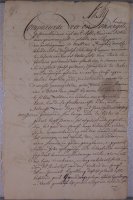
| Article by
Scott Balson, January
2007. Copyright is given to the City of Kokstad to use this article on their web site at kokstadonline.co.za. |
Scott's 350 page book "Children of the Mist, the lost tribe of South Africa" covering the history of the Griqua people will soon be published in South Africa. You can find out more at this link - http://www.griquas.com |
One has to no look further than the name to get a good grasp on the fascinating history of the historic town of Kokstad.
The name "Kok" is synonymous with the Griqua people, the community which
founded the town in the most extraordinary of circumstances. To understand
the Griqua people we need to go back to the year 1652 when Jan van Riebeeck
set up camp at the Kaap de Goede Hoop, or Cape Town, on behalf of the Dutch
East India Company - a global financial giant in its day.

Cape Town was required as a port where sailors could relax and recuperate while travelling from Europe to the Far East. It was these same lonely sailors and later the first settlers who would entrap the indigenous females, the Khoi-Khoi, or Hottentots resulting in a new breed of coloured men and women who were rather derogatorily called "Bastards".
Life for the "bastards" and Hottentots was all down hill from 1652. This nomadic, pastoral, community-based people were soon labelled as thieving and lazy as white men moved in and claimed their traditional lands. Within a few short years only Bastards and Hottentots working for their new white masters were allowed in the white settlement areas which expanded north into the interior of what is today the south western Cape region. The "free" Bastards continued to move inland escaping the captive life under the white people who would later become the Voortrekkers.
Image right: An early Dutch East India land grant made in the Cape
It was Adam Kok who first led a small multiracial group of Bastards, Hottentots, blacks and white rejects across the Orange river into new lands around the historic towns of Griqua Town (formerly Klaarwater) and Kimberley. In 1795 the British took control of the Cape and soon after the London Missionary Society (LMS) was using this new colonial outpost as a base for saving black souls.
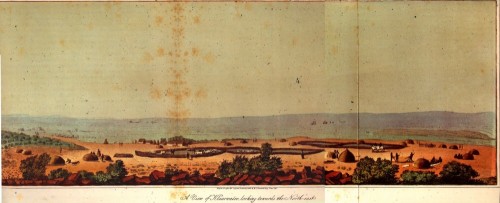
Klaarwater, Griqualand West in 1811 - drawing by Burchell
In 1811 William Burchell, the noted botanist after whom the zebra gets its name Equus burchelli, visited the Griquas and expressed in his book his disappointment in their life style which he found, like others before him to be, the laziness of the Hottentots, and of the great difficulty there had always been in persuading them to work, either on the buildings or in the garden; and in this complaint there was too much truth..
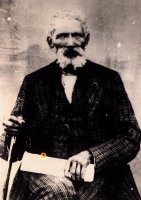 It is a fact that throughout their
history the cultural roots of the Bastards/Griqua would never be understood
by white culture and, as a result, their fate was cast long before the white
man followed these true voortrekkers into central South Africa.
It is a fact that throughout their
history the cultural roots of the Bastards/Griqua would never be understood
by white culture and, as a result, their fate was cast long before the white
man followed these true voortrekkers into central South Africa.
It was at Klaarwater/Griqua Town that the missionaries established their mission station among two main Bastard families, the Koks and Barends. In 1813 a Director of the London Missionary Society, Rev John Campbell, met with the leaders and the families resolved to take on the name Griqua, after the name of a Hottentot clan on which the community had its origins. Campbell also talked about introducing a coinage into the community to facilitate trade but this never happened as the London Missionary Society refused to fund his mad-cap scheme.
Image right: Nikolaas Waterboer the Griqua leader who returned to Griqua Town in 1820. Waterboer was descended from the bushman tribe.
In 1814 the Griquas at Griqua Town moved out after the resident missionary, William Anderson, endeavoured to get some twenty young Griquas to join the Cape Colonial Force. Adam Kok II and Barends, the leading families, left Griqua Town as a ghost town setting up home at Campbell and Daniel's Kuil.
The Griquas under Adam Kok moved to Philippolis in 1827 claiming the lands between the Orange and Modder rivers as their own. To the south the voortrekkers were starting to revolt against British rule and, in particular, laws which outlawed slavery. By 1834 thousands of voortrekkers had started to cross the Orange River and graze their large herds of cattle and sheep on the lands already occupied by the Griquas.
The conflict over land rights between the two cultures grew and grew, the
annexation of Natal by the British further exacerbated the position as boers
fled over the Drakensberg into the lands now claimed by the Griquas. Forty
year leases over large acreages owned by Griquas were taken out by boers
under extraordinary circumstances, sometimes a bottle of brandy was all that
was required to secure a lease from a Griqua landowner. By the late 1840s
the boers had established their own Oranje Vrij Staat (Orange Free State)
with Bloemfontein as their capital. The borders of this new state rode roughshod
over the lands previously claimed by the Griquas based at Philippolis. The
Governor of the Cape, Sir Harry Smith, was called in to arbitrate. He considered
the Griquas to be lazy and sided with the boers in an effort to buy peace
- within ten years much of the land once owned by the Griquas was claimed
by the boers and Kok and his followers were forced to leave Philippolis at
the barrel of a
gun.
Image right: Turn off on the R56 between Kokstad and Matatiele to Droevige Toestand where Pommer nearly starved
Following the Kat River rebellion a fascinating young Hottentot by the name of Smith Pommer fled to Nomansland in the 1850s. He started cattle rustling and stirring the African tribes up against each other. Following a raid on the Baca people Pommer and his followers were routed by the tribe who vowed to kill him. The small band of outlaws fled to a place they called Droevige Toestand - as the name suggests the fertile valley, near where Kokstad stands today, was a place of desolation for them. Despite the abundant game living there at the time Pommer and his followers were forced to eat their own dogs as they had no guns or ammunition.
Adam Kok's fate in the Orange Free State was much worse. For months his outcast people gathered at a place called Hanglip near the border of Basutoland where their wealth in livestock and wagons was counted in tens of thousands and hundreds. It was at this time Pommer approached Kok to move to Nomansland - a suggestion he jumped at. The white traders who lived among the Griquas made such a good living that they followed this small multiracial nation across the Drakensberg in 1861 and into their new home, Nomansland.
 Nomansland
gets its name out of tragedy - it was the great Zulu warrior Chaka's impis
who literally decimated the African tribes who once lived here. It is, even
today, a remote region nestled between the Drakensberg to the east, Pondoland
to the west, the Cape to the south and Natal to the north. When the Griquas
arrived in Nomansland, after coming down the Drakensberg through the unforgiving
Ongeluksnek (click on image right), the arduous eighteen month journey sapped
the life out of them.
Nomansland
gets its name out of tragedy - it was the great Zulu warrior Chaka's impis
who literally decimated the African tribes who once lived here. It is, even
today, a remote region nestled between the Drakensberg to the east, Pondoland
to the west, the Cape to the south and Natal to the north. When the Griquas
arrived in Nomansland, after coming down the Drakensberg through the unforgiving
Ongeluksnek (click on image right), the arduous eighteen month journey sapped
the life out of them.
Just a tiny fraction of their large herds survived the trek and very few
of their ox wagons made it in one piece. So it was that Adam Kok III settled
with his people at a place called Mount Currie in 1862. They described their
new home thus "The grass was too long, the winter too cold, the rains
too heavy, the markets too far, the money too scarce, the merchandise too
dear the kaffirs too 'parmantig'."
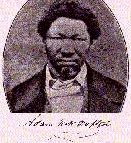
Image right: Adam Kok - from Dower's book
A group travelling through Mount Currie described the settlement thus, To our
disgust and disappointment we found it (the laager) a very dirty place,
consisting of about 200 mudhuts, a few old wagons, and a lot of dirty old
Griquas sitting or lying outside their dens. A small church and a fort in
the middle of the village and Adam Kok's house at one end. Adding to the
miserable appearance of the laager a number of houses half built and allowed
to remain with their four walls standing.
It is, indeed, as one of our party called it, a village in ruins before
it was built.
For many years the Griquas resisted moving from Mount Currie to Kokstad. During this time very few whites settled in the area and Nomansland was renamed East Griqualand.
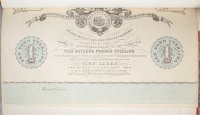 One of the first tangible decision
of the Griqua Raad at Mount Currie was the printing of 10,000 £1 bank
notes (seen right). The Griqua people had grown used to the Rix Dollar currency
in the Cape but now their isolation had forced them into barter. It was thanks
to the quick thinking of their magistrate at Umzimkulu, Donald Strachan,
that the paper notes were impounded and later burnt before they could financially
bankrupt the new Griqua state. A few copies of the unused bank note still
exist in Rev W Dower's 1902 book "The Early Annals of Kokstad and East
Griqualand".
One of the first tangible decision
of the Griqua Raad at Mount Currie was the printing of 10,000 £1 bank
notes (seen right). The Griqua people had grown used to the Rix Dollar currency
in the Cape but now their isolation had forced them into barter. It was thanks
to the quick thinking of their magistrate at Umzimkulu, Donald Strachan,
that the paper notes were impounded and later burnt before they could financially
bankrupt the new Griqua state. A few copies of the unused bank note still
exist in Rev W Dower's 1902 book "The Early Annals of Kokstad and East
Griqualand".
To understand the circumstances behind the birth of Kokstad one has to read this book or it's more readily available 1978 reprint, however, I have summarized some of the main events below.
 In the book Dower describes how the site for the town
of Kokstad was selected in 1869, the original layout being prepared by surveyor
Edward Barker. A stick protruding from a large antheap and adorned with a
white handkerchief marked what would become the city centre. The land originally
belonged to Martinus Davids who happily took title to the land where a Griqua
town would be built and accepted the clause of no compensation as he scoffed
at the idea of the Griquas moving from Mount Currie. How right he was, for
a time!
In the book Dower describes how the site for the town
of Kokstad was selected in 1869, the original layout being prepared by surveyor
Edward Barker. A stick protruding from a large antheap and adorned with a
white handkerchief marked what would become the city centre. The land originally
belonged to Martinus Davids who happily took title to the land where a Griqua
town would be built and accepted the clause of no compensation as he scoffed
at the idea of the Griquas moving from Mount Currie. How right he was, for
a time!
Image right: the exposed slope of Mount Currie where the Griquas first settled
Despite the best efforts of, Dower, Brisley, the Griqua Raad and Adam Kok III the Griquas refused to move from the unfriendly slopes of Mount Currie. In early 1871 the Chief addressed the community at a well attended meeting held where the centre of Kokstad lies today. By this time Barker had marked off the lots and a water trough brought fresh water into the town. At this meeting Kok spoke passionately about the need for the community to move from their shanties on Mount Currie to a town which had been properly surveyed. He said "There are plenty of erven, they are all equally good, and of equal size. The price is nothing; only when you have made your selection you must register your choice with the Secretary, Charles Brisley, who will give you a ticket of allotment".
 The Griquas listened, returned to their homes at Mount
Currie and did nothing. It needs to be understood that, until this time,
Kokstad had not been named and was simply called "NewTown" by the Griquas.
The Griquas listened, returned to their homes at Mount
Currie and did nothing. It needs to be understood that, until this time,
Kokstad had not been named and was simply called "NewTown" by the Griquas.
Image right: The Griqua Church in Kokstad today
The only erven taken up in 1870, according to Dower, were, a block of six for the Griqua Church, a Government erf on which the Public Office stood in 1902, Adam Kok's erf and site of the old "palace", Charles Brisley's erf which was later used as a site for a shop, and an erf near the Royal Hotel acquired by the Griqua Raad. Not one free erf was taken up by the hundreds of Griquas who must, at that time, have viewed the idea of moving to a new town as ridiculous!
Dower resolutely went ahead with the building of his Parsonage in the NewTown and records in his book how on the 19th May 1871 he took up residence in the first building in what was a ghost town. He would drive his wagon up to the Laager at Mount Currie every Wednesday and Sunday to deliver his Church service to the community.
In mid 1872 Dower informed the community that he would stop delivering Church
services at the Laager and would now conduct them in the spot where the new
Griqua Church was being constructed in NewTown. This attempt to get the people
to move was, in Dower's own words, a "distinct failure" and no-one attended
his services, but luckily fate played into his
hands.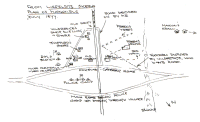
It was shortly after Dower made his stand on a morning following a particularly cold, wet and windy winter night that Adam Kok tired of the unpleasant conditions on the mountain slopes. He called his people together and rallied them around demanding that they join him in the NewTown.
Click on the image right to see a drawing of Kokstad in 1877.
At this same meeting the Griqua Secretary, Brisley, addressed the meeting and suggested that the NewTown be called Kokstad to honour their leader. (Stad is the Afrikaans for "city" - in effect "Kok's city"). The Griquas taken with the name and honour bestowed on their leader belatedly started to move to their new capital.
Dower records how the one of the first buildings built in Kokstad was a wagon house. It's walls were made of sod and payment by Dower to the Griqua builder, Francis Meintjes, was by way of a Geneva Clerical Coat that Francis wore with great pride.
In these early days of Kokstad money was so scarce that nearly all transactions that took place were by way of barter - even taxes collected by the Raad were often of a four-footed kind. So it was that an extraordinary event took place which would transform the isolated but growing community in East Griqualand. Three powerful men, the Griqua Secretary, Charles Brisley; and the brothers Thomas and Donald Strachan (the only white Magistrate elected by the Griquas and the only white man in South Africa to be given the honour of "Chief" by an African tribe) established a set of trading stores across East Griqualand and introduced their own currency in 1874. The Strachan and Co trade tokens were used widely across a region the size of Ireland as cash for nearly sixty years. Over this time four identifiable sets of brass coins holed at 12 o'clock and bearing the values of 3d, 6d, 1/- and 2/- now claim the numismatic fame of being South Africa's first indigenous currency. These humble tokens were the fire that drove the economy in East Griqualand right into the early 1900s.

The first of the four famous Strachan and Co trade token coin sets
- used as currency in East Griqualand for over fifty years
Dower reflects in his book how the Strachan and Co trade tokens gave the Griquas reason to sell their land because with the money they could buy things in the stores rather than have to barter goods for goods. The Standard Bank of South Africa, which opened its doors in Kokstad in 1878, at the request of the British Governor in the Cape, Sir Bartle Frere, accepted and distributed these trade tokens as money - the shortage of imperial coin and the isolation of the region leaving them no choice. A trading empire had, in effect, become the regional reserve bank.
The sale of land by Griquas followed the same sad pattern as before … and soon very few Griquas remained land owners with some large and valuable 3,000 acre farms around Kokstad being sold for a bottle of brandy.
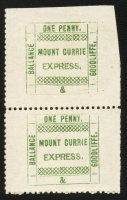 There were other uniquely East
Griqualand private services like the Goodliffe and Balance Mount Currie
Express penny stamp (image right) - one of the rarest postal oddities
in the world today. This stamp was used for a short while in 1874 by Goodliffe
and Balance as payment for carting packages from Mount Currie to Kokstad,
Umzimkulu and other settlements within the region.
There were other uniquely East
Griqualand private services like the Goodliffe and Balance Mount Currie
Express penny stamp (image right) - one of the rarest postal oddities
in the world today. This stamp was used for a short while in 1874 by Goodliffe
and Balance as payment for carting packages from Mount Currie to Kokstad,
Umzimkulu and other settlements within the region.
In 1874 the first buildings in Kokstad were erected including the Griqua Church and Dower counted about eighty houses dotted across the plain. In those early days the town was somewhat unkindly referred to as "Sodville" or the "City of Sods". Dower records how, at this time, he could have bought up half the erven in Kokstad for just 20 shillings as the Griquas were ready sellers saying "Mynheer moet toch myn erf koopea ik benheel uit kos". ("Buy my erf, do, please sir, I have no food")
Despite the impression of slothfulness the Griqua people, supported by the first white settlers, did succeed in clearing the region of the marauding native vagabonds, thieves and murderers who had, before their arrival, created havoc in Nomansland. The Griquas also faced several battles with neighbouring black tribes but it was, largely thanks to Donald Strachan's own private multiracial army, the Abalandalosi, that these disturbances were quickly dealt with.
It was at this time that the Governors of the Cape and Natal turned their eyes longingly at the land now occupied by the Griquas. In 1874 the Cape Colony decided to annex East Griqualand. Joseph Orpen, who had no love for the Griquas, was sent out as the British Resident to inform the people of the Governor's decision. At this meeting Kok stood up and tearfully exclaimed "There you have it, we were not consulted. We can say nothing".
On the 30th December 1875 Adam Kok died in a tragic accident when the wheel of his cart hit a large rock as he was travelling from Kokstad to Umzimkulu. His death came shortly after he fell out of the cart and a wheel crushed his chest. The last Griqua leader was dead without an identifiable heir.
The leaderless people were now faced the Cape Colony's might when, just weeks later, in January 1876 Captain Blythe accompanied by a small army of men arrived in Kokstad and informed the Griquas that he had been elected Chief Magistrate and ruler of the territory. The view of the Griquas was that they had been taken over like cattle or sheep.
Image right: Three Griquas stand proudly outside
the Kokstad Museum.

During the next few years a high degree of political instability shook East Griqualand. This was further aggravated by Griquas selling their land cheaply to European settlers - the Griquas had literally given away their valuable land holdings (rural farms and plots in Kokstad) in exchange for food, or worse, a bottle of brandy. Eventually in 1878 the British decided to formalise their control of the territory that they had earlier given to the Griquas. This was a move that was behind the short-lived Griqua revolt of 1878 - a rebellion led by the notorious Griqua bandit who had first brought the people there, Smith Pommer.
In 1878 shortly after the Griqua Rebellion was quelled the armoury in Kokstad
was blown to pieces in an accident that killed several of the early white
settlers including G P Stafford (Donald Strachan's clerk),
 James Pringle (the Kokstad store
owner in who's store the events behind the rebellion were fermented) and
a young white lady from the town.
James Pringle (the Kokstad store
owner in who's store the events behind the rebellion were fermented) and
a young white lady from the town.
Image right: The tree in the back of a Kokstad Schoolyard marks the exact spot where the armoury blew up.
It is believed that the drunken revelers, in the party following the victory over the rebel Griquas, had gained access to the armoury. In this small room with over 5,000 pounds of gunpowder the injudicious lighting of a pipe led to the deadly explosion which was heard up to thirty miles away.
In 1879, following their defeat by the British the Griqua nation was disbanded and the territory incorporated into the Cape Colony.
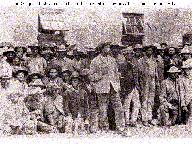 Image right: Le Fleur and his followers outside the Kokstad
Magistrates Court in 1898 following their arrest on sedition
charges.
Image right: Le Fleur and his followers outside the Kokstad
Magistrates Court in 1898 following their arrest on sedition
charges.
Even after this time battles with the natives continued and Strachan's native voluntary army, the Abalandalosi, now numbering some 3,000 men served as the local army. Mrs E C Coetser, a member of an Afrikaner family who settled at Cedarville, noted when they fled to Kokstad at the start of the "Gun War" in 1880: "Strachan het al die lojale kaffers opgeroep... Honderde lojale bongeverfde kaffers (Baccas) het die dorp... ingekom, gesing, geskree en geslaan op hulle skildevelle wat 'n mens senuweeagtig gemaak het... Die kaffers was tien teen een witman." (Translated: "Strachan called all the local blacks, hundreds of loyal armed Baccas entered the town (Kokstad) singing, shouting and hitting their shields making a person very nervous as there were ten blacks to every white."
Even Dower was fearful of the Abalandalosi, he recorded, They entered Kokstad several hundred at a time. They came along singing their war song, beating their shields all in rhythmic time making a weird, and to unaccustomed ears, a terrible sound. More than once I felt not a little nervous when these fierce armed and mounted men, with the frenzy of war upon them - some in full war paint - stood two deep round the Market Square.
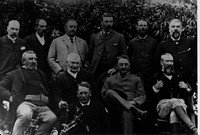 Image
right: Taken at Brook's Nek at the annexation of Pondoland by the British
in 1894. Standing L-R: Guy White; A H Williams; C Woodroffe; Middleton; Hugh
Nourse; Capt Wynous. Seated L-R: Donald Strachan (East Griqualand's most
famous pioneer); John Scott; Cecil Rhodes (Prime Minister of the Cape Colony);
Major Hook (FAMP)
Image
right: Taken at Brook's Nek at the annexation of Pondoland by the British
in 1894. Standing L-R: Guy White; A H Williams; C Woodroffe; Middleton; Hugh
Nourse; Capt Wynous. Seated L-R: Donald Strachan (East Griqualand's most
famous pioneer); John Scott; Cecil Rhodes (Prime Minister of the Cape Colony);
Major Hook (FAMP)
Yet this volunteer group, despite quelling numerous tribal uprisings in East Griqualand, never received any payment or compensation for their work. Despite operating under the auspices of the British Governor in the Cape not one of their number, including their Commander Donald Strachan, was rewarded with a Cape of Good Hope General Service Medal.
The Abalandalosi was eventually disbanded by Strachan in the late 1800s not long after they rounded up le Fleur and a few followers who, it was claimed by white settlers, were attempting to undermine the peace.
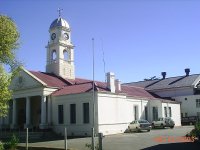 And so if we look at the remarkable origins of Kokstad
we see a city which was founded by the first inhabitants of South Africa,
a people who left their name across great tracts of the country - Griqualand
West and East Griqualand.
And so if we look at the remarkable origins of Kokstad
we see a city which was founded by the first inhabitants of South Africa,
a people who left their name across great tracts of the country - Griqualand
West and East Griqualand.
A pioneering people who were displaced time and again, arriving at last in Nomansland - before they were scattered across South Africa. The only tangible evidence of the role of the Griqua today in East Griqualand is the name Kokstad on the map. The only remaining Griqua community of note today resides at Plettenburg Bay under the Chieftainship of Alan Andrew le Fleur (fourth generation leader) who took over this role in November 2005.
And so it is that Kokstad, a historically rich name, today reflects very little of its turbulent but pioneering past.